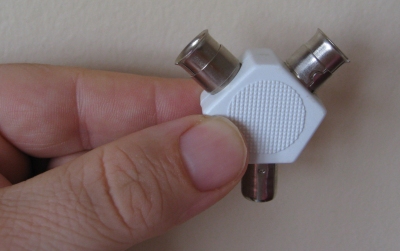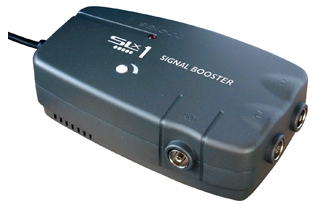| No Freeview Channels? Missing Freeview Channels TV Interference Freeview Coverage Indoor TV Aerials |
Advice on Retuning Freeview Signal Boosters Recording Freeview Freeview Reception Help TV Connectors |
On this page, we offer advice on how to split an aerial feed so that it will feed multiple rooms or bits of equipment. We also discuss signal boosters.
How do I split my aerial feed?
You would typically need to split an aerial feed if you wanted to connect your TV aerial to a TV and a recorder, or if you wanted to split the aerial feed so that it could feed two Freeview digital TV receivers in your home.
There are two types of way to split an aerial:
1. An aerial splitter.
These are typically "T" or "Y" shaped metal of plastic. Into one end, you plug your TV aerial, then you connect other TV flyleads to allow you to feed multiple TV sets or a TV and a recorder. Assuming you’re in a decent Freeview signal strength area, you’re not using cheap aerial cabling, and you’re not running cables over along distance, one of these should do the job.
Aerial splitters are available from www.maplin.co.uk for around £5. (Note that the TV aerial has to be connected to the ‘foot’ of the ‘T’ or ‘Y’ for the correct result)

An aerial cable splitter
2. A signal booster with multiple outputs.
Get a signal booster with multiple outputs – as these have an amplifier, they can help to reduce signal loss when connecting over a long cable run, or where a splitter is introducing interference. See below for more on signal boosters.
Signal boosters and amplifiers
Signal boosters are mains-powered units that amplify an aerial signal. These can be handy if you’re in a weak signal area, but they are also useful if you want to feed a single aerial connector to lots of TV sets or equipment.
Running lots of cable around your home adds "loss" to the signal, and a booster can be invaluable to keeping that loss to a minimum. Connect a booster to your aerial, then connect each piece of equipment to the booster. You can get boosters with 1, 2, 3, 4, 6 and 8 outputs.
You can pick up a booster from Argos (use Click and Collect), and you can also get a decent selection of boosters from Maplin: See Maplin’s list of boosters and amplifiers.

The SLX1 Digital TV booster from Maplin
Other things to know about boosters:
Effectiveness: Note that signal boosters are not always effective. If you are getting a poor signal that’s giving you lots of interference, a booster will not only boost the signal, it will also boost the "noise" that’s causing interference.
TV Link: If you’re planning on using a TV Link / Magic Eye to change channels remotely, look for a booster with ‘digital passthrough‘.
Specification: Check the specs of any booster you’re considering:
- "Output gain" – Measured in dB (decibels). The higher the number, the more boost.
- "Noise" – Generally, the lower this figure is, the better. Also measured in dB.
Getting your TV in other rooms
We have a page dedicated to helping you get TV in other rooms – see our TV in other rooms page.
Need more help?
Ask in our Freeview Problems forum – Please include your postcode, plus the make and model of your Freeview receiver, as this helps the forum regulars provide relevant advice.

